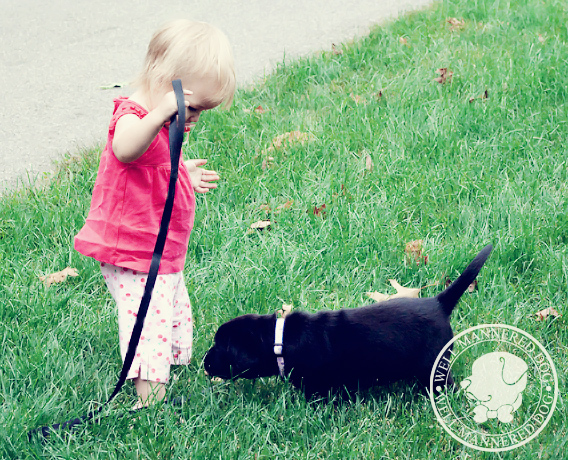
Getting Kids To Help with Dog Training

Always Supervise Your Child While Working Commands
So, you’ve got a dog and you’ve got kids. What can you do to get the two to mix in a way that is positive and rewarding? LOTS OF THINGS! Here are just a few ideas:
Cheerleading!
When you are teaching a dog its commands, and it begins to clue in on the routine, kids can be great cheerleaders! Have them stand by on the ready to praise the dog and love the dog (without over exciting them to the point of losing focus) when they do something right! Make sure the praise comes at the right time: when the dog is doing what it is meant to do. Your kids will learn appropriate praise times, and your dog will learn to behave! If you are using clicker conditioning, and your dog can take the treats nicely, let your child be the “candy machine”! Praise is any form of the dog getting what it wants: attention, praise, play, treats, petting, etc. Cheering for a dog can include any of those things.
Hide and Go Seek!
Reinforce your “come” command by playing Hide and Go Seek! That’s right! Put your dog in a sit/stay. Have your child hide. When you give a predetermined signal (“you’re through” releasing the dog from its stay is always a good one, but a whistle or a clap will work too), have the child repeatedly call your dog’s name and say your family’s come command over and over again. When they hear the dog coming, tell them to praise their dog. Make sure your child makes it really exciting for them to be found. Upon finding your child, make sure the dog is commanded to sit. Then give lots of love! Your dog will rush from hiding spot to hiding spot to find your child to be rewarded with their attention. If you want to, you can also change it up by adding a new “FIND” command. Make the signal to your children to begin their calls when you say “FIND [insert child name here]”. Then they can go find that person for you! This is helpful when you want to burn mental energy as well as physical energy for both the dog and the child. That can come in handy when its raining outside!
Double Leashing
What do you do if you have children in your home that want to help with the training of the dog? By all means, let them. But be smart about it. Letting a child handle the leash of a dog, or give the dog commands can only be done in one of two cases: (1) the dog is more than proficient and consistent with its obedience, or (2) you are there to assist them. Never train the dog around a child if you are not confident in your ability to command your dog. You don’t want to inadvertently exhibit any negative behaviors in front of your “student trainer”. Never have a child, especially a small one, give commands or handle the dog without supervision. With that said, here is a great way to help your child to gain an understanding of canine ownership and companionship: double leashing.
When you are working with your dog, put two leashes on them. One that is longer for your smaller partner, and one that is shorter for you. With this in place, you can teach your partner proper leash handling and command techniques, while maintaining the ability to reinforce the commands for them in the event they are unable to do so themselves. For instance, if your student gives your dog the command to SIT/STAY with the correct tones and hand signal, and your dog does not do it: Have your child/student say NO, and then (assuming they are unable to) you step in and correct the dog by placing them in the correct position. Praise your child for their correct performance, and have them try again. With practice, your dog will understand that the child has the power to command them. This can also be useful when walking your dog. If you are working on control walk, have the child walk with the longer lead, while you work the shorter one. If the dog will walk with you in a heel position, all the better. Step off onto your walk with your dog in heel, while your child leads or follows using the longer lead. They are helping you to walk the dog! Then try having your dog heel to your child, while you reinforce with leash corrections when necessary. Remember, to be consistent your students (dog and human) must perform their tasks in a way that is consistent with your training so that you don’t lose any of your hard work!
PREVIOUS POST: Pleasure to Meet You
NEXT POST: Potty in One Spot
© 2013 Well Mannered Dog Training Charleston, SC
TAGS: Dog Games, Dogs and Kids, Obedience Training